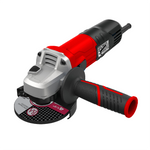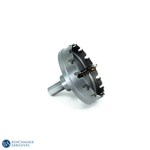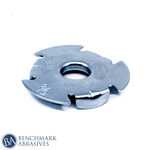
What Are The Common Causes Of Grinding Wheel Accidents, and How Can They Be Prevented?

Accidents using grinding wheels are among the most hazardous situations for users of these kinds of equipment. Accidents with grinding wheels can have disastrous results. Grinding wheels are utilized extensively in many different industries, ranging from do-it-yourselfers to more demanding building projects and heavy-duty, continuous industrial applications.
In this blog, we’ll cover all the common causes of grinding wheel accidents and the steps taken to prevent them.
The Common Causes Of Grinding Wheel Accidents
Grinding wheel accidents can cause severe injuries like cuts, eye damage, burns, and much more. Most of these accidents can be avoided by understanding the common causes and by taking the appropriate safety measures. Let’s discuss the common causes of grinding wheel accidents before discussing their prevention.
1. Wheel Breakage
The primary and most popular cause of grinding wheel accidents is wheel breakage. There are several reasons or factors behind wheel breakage:
-
Overspeeding: it is the condition where the wheel is beyond its maximum operating speed that will lead to excessive centrifugal force, which disintegrates.
-
Improper Mounting: this involves using improper or damaged flanges, overtightening the spindle nut, or ignoring utilization blotters, which can result in uneven pressure and stress points.
-
Wheel Damage: this includes the physical damage to the wheel, like cracks or chips by mishandling or impacts, resulting in the weakening of the wheel’s structural integrity.
-
Incorrect wheel for the job: selecting the incorrect or inappropriate wheel for your project can cause failure or damage to the wheel or the workpiece due to the generation of excessive heat or force.
-
Improper machine conditions: this includes loose spindle or excessive vibrations
-
Unequal coolant distribution: can cause the wheel to overheat and also damage the workpiece
-
Improperly clamped workpiece: can cause vibrations, movements, or twisting of wheels.
2. Contact With The Wheel
Direct touch with the rotating grinding wheel is a common cause of a serious risk of accidents. This happens because of the following factors:
-
Accidental Touching: accidental touching also refers to unintentional contact or touching the grinding wheel while working. Several factors can cause this, but it mostly occurs due to the lack of stability such as slipping on a cluttered floor because of uneven ground in the workspace. Also, when machine guards are missing, misaligned, or broken, they fail to establish the required physical barrier, and the quickly spinning abrasive surface remains uncovered and prone to accidental contact. Additionally, handheld angle grinders running at high speed are prone to cause accidental touch as the operator might lose control while working with them.
-
Entanglement: Another common cause that may occur when working with an angle grinder is the risk of entanglement. Loose clothing, long and untied hair, and jewelry like necklaces or bracelets can pose a risk of serious entanglement, as the moving parts of the wheel are capable of grabbing these objects, which results in minor to severe injuries like crushing or tearing. The quick rotation of the wheel makes any entanglement particularly risky, which can swiftly bring the operator closer to the wheel before they have a chance to respond.
-
Lack Of Machine Guard: the lack of proper machine guards on grinding equipment increases the risk of accidents. These guards act as physical barriers avoiding accidental contact between the user and the rotating wheel. In the absence of these safeguards, there is a chance that your hands, fingers, or other body parts can come closer to the quickly moving abrasive surface, which leads to potentially serious injuries like cuts, abrasions, or amputations.
3. Flying Debris And Sparks
Flying debris and sparks are mostly generated during the grinding process, which can cause severe injury to the user and those nearby. When an abrasive wheel comes in contact with the workpiece, tiny particles of the wheel material and the material being ground are aggressively released at high speeds causing severe risk to the operator.
This risk is further increased in the case of wheel fragments, as larger or sharper pieces of the wheel are thrown away with a certain amount of energy. Also, the friction produced during grinding mostly generates hot sparks that can cause burns when they come into contact with skin or clothes and can cause a severe fire risk if flammable items are nearby. Without taking the right safety measures, these flying sparks and debris can hit the face, eyes, and other exposed flesh, causing burns and other serious injuries as well as mild irritation and superficial cuts.
4. Kickback
Kickback is a sudden and powerful reactive movement of the workpiece or grinding tool that can happen surprisingly during operation. This usually happens when the grinding wheel suddenly snags, jams, or binds on the material being processed. There are several factors or reasons that cause kickback, including using the incorrect type of wheel, operating at an inappropriate speed, using a dull or damaged wheel, or using a wheel whose cutting edges are not correctly adjusted.
The grinder may jerk or be flung out of the operator's control if the wheel runs into resistance or is pinched, as this transfers the rotating force violently back to the machine. This abrupt loss of control may cause the operator to lose their hold, which might cause serious harm if they come into touch with the wheel that is still turning or get hit by the workpiece or recoiling tool.
5. Improper Usage And Operator Error
Improper use of tools and user's mistakes contribute to a large percentage of grinding wheel accidents. This includes a number of factors like lack of training, applying wrong techniques, lack of safety measures, or distraction due to fatigue. All these factors can contribute to severe accidents when working with high-speed grinding wheels.
6. Inadequately Maintained Or Defective Equipment
The overall condition of the grinding machine itself plays a critical role in operator safety. Defective or badly maintained machinery is an important factor that contributes to accidents or injuries. A grinding machine with a loose or defective spindle can lead to excessive vibration and instability, which can increase the risk of breakage and be difficult to control. Malfunctioning or incorrectly fitted work rests provide insufficient support for the workpiece, which could allow it to move uncontrollably and perhaps collide violently with the wheel.
The machine's safe operation can also be affected if regular maintenance is avoided. This includes lubricating the moving parts or ensuring appropriate belt tension, which can further lead to wear and tear. Working with poorly maintained or damaged equipment not only increases the possibility of wheel failure and losing control but also affects the effectiveness of safety measures designed to keep the operator safe.
7. Unsafe Working Environment
Unsafe working environments can also lead to severe accidents while operating grinding wheels. This involves several factors like obstacles on the floor which lead to trips and falls; inadequate lighting, which reduces the visibility and causes accidents; or the presence of flammable objects nearby that can cause a serious fire risk during operation. It may be challenging to keep your balance and control in these conditions. Therefore, tackling these environmental issues is crucial in maintaining safer grinding operations.
Prevention Of Grinding Wheel Accidents
After understanding the common factors that cause accidents during grinding wheel operation, now let’s discuss how grinding wheel accidents can be prevented. Here is the list of necessary prevention taken during the operation.
-
Training and Competency: Make sure that all users are trained properly on carefully using the grinding machines and abrasive wheels like mounting, dressing, and operating processes.
-
Pre-operation checks: before starting the grinding operations it's crucial to pre-operation checks for enhanced safety. This involves the following factors:
-
-
Inspection of grinding wheels – always inspect the grinding wheels for any chips, cracks, or any other defect before starting the process. For more safety, ensure to do a ring test on vitrified wheels to check for their soundness.
-
Verify wheel specifications – ensure that the maximum operating speed of the wheel is equal to or greater than the grinder's RPM. carefully examine that the wheel is suitable for the material as well as the project.
-
Examine the grinder – Make sure the machine is in good operating order, the work rest is positioned appropriately (within 3 mm of the wheel), and all guards are installed and operating as intended.
-
Examine mounting components – Ensure to use clean, undamaged, and right-sized flanges and blotters. Adjust the spindle nut properly so that it is neither too tight nor too loose.
-
-
Use Of Personal Protective Equipment: ensure to use personal protective gear before starting the grinding process. Protective gears include safety glasses, face protection or helmets, gloves, dust masks or respirators, safety shoes, appropriate clothing, and hearing protection. All these safety gears will protect the user from getting severe injuries or potential accidents while using the grinding wheels.
-
Safe Operating Procedures: Ensure to strictly follow safe operating operations which is crucial in preventing grinding wheel accidents. This includes a number of factors like Correct wheel mounting, which is essential for stability and also prevents damage, applying moderate pressure so that the material and the wheel do not overheat, and proper workpiece support using clamps so that the material does not slip or move during the cutting process. Also, don’t stay in one place for too long, as this can cause overheating and damage to the wheel and material. Remember to stay to the side of the grinder for the first minute to ensure that there is no wheel failure.
-
Wheel Storage & Handling: how grinding wheels are stored and managed affects their safety as well. Proper storage means that the wheels should be kept in a dry, temperature-controlled area, ideally on racks that are specifically made to offer enough support and avoid any physical damage to the wheels. ensure proper handling or managing of the wheels, especially in case of transport and movement, where there is a chance of dropping or bumping the wheels. the wheels should never be rolled on the floor.
By strictly following these procedures, you can easily prevent any wheel damage or potential accidents and also it helps in maintaining the wheel's integrity.
-
Safe Working Environment: ensure that your work area is clean and safe from any flammable objects. This will enhance the performance as well as prevent accidents.
-
Regular machine maintenance: Ensure to regularly check and maintain the grinding machine before and after each process to make sure that they are in good working condition and there are no signs of any damage.
By understanding the common issues and carefully implementing the prevention, one can eliminate the risk of grinding wheel accidents which results in a safer working environment.



































































